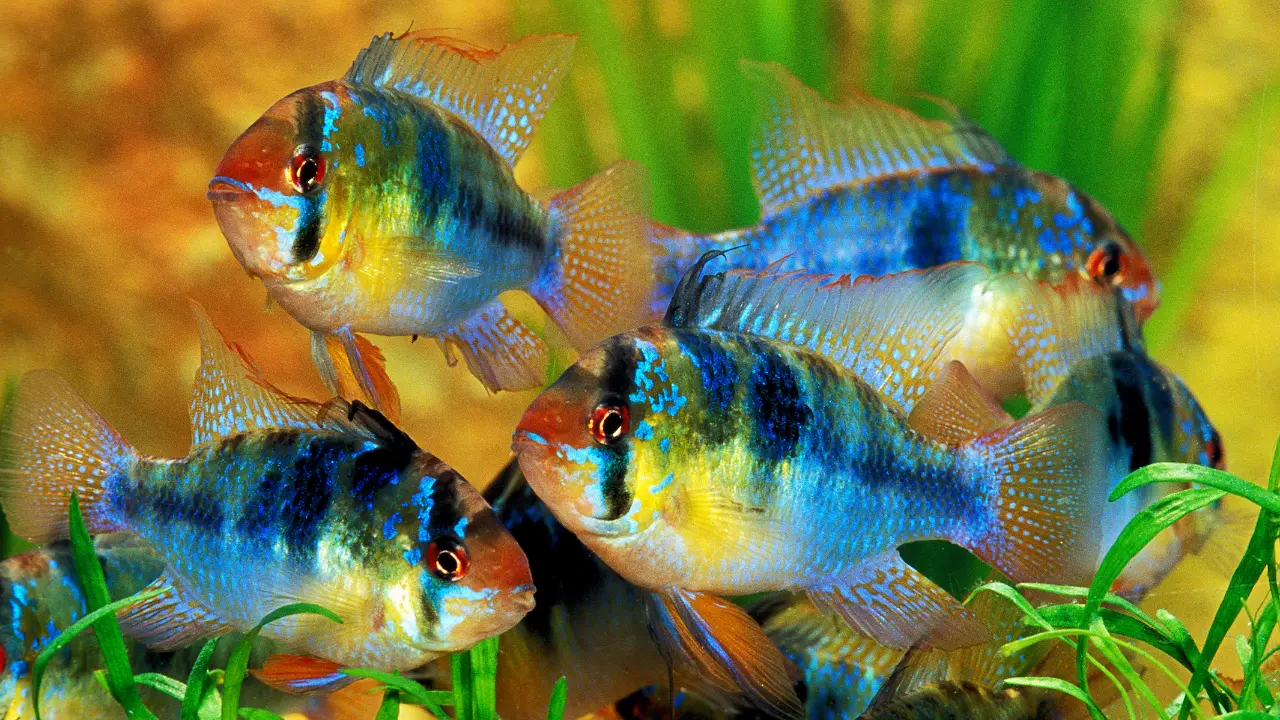The German Blue Ram is a combination of both beauty and complexity. Its unique looks and personality make it a favorite of aquarists worldwide. But finding the right guidance to nurture this intriguing creature can be a little hard. But worry not! because we are here to let you know all about the Ultimate German Blue Ram Care Guide.
With great tank creatures, comes great responsibility! To make it easier, we’ll be exploring the origin, looks, tank setup, and care tips for the German Blue Ram cichlid and much more. But before that let me ask you: What exactly draws you to these mesmerizing fish? Is it their beauty, temperament, or unique personality? Whatever it might be, the Blue Ram is a showstopper for every tank in town.
Before adding this fish to your tank, you should know that the German Rams are facing habitat loss on a large scale. Moreover, this fish has become a victim of predation. This is becoming dangerous for the overall population of the German Blue Rams. So, ask yourself if you are ready for this responsibility and only then make a decision.
Whatever your decision is, exploring the German Blue Rams is no less than an adventure. So come along and take a look at the German Blue Ram’s underwater world.
Check out our quick care guide for the German Blue Rams
Quick Care Guide
| Minimum Tank Size | 20 gallons at least |
| Water PH | 6.0 to 7.0 |
| Water Temperature | 78°F – 86°F |
| Care Level | moderate |
| Maximum Size | 2.5 inches |
| Tank Mates | Yes (similar or smaller-sized fish) |
| Diet | Omnivores |
For a more detailed overview of the German Blue Rams, check out the following article.
German Blue Ram Origin
Scientifically known as Mikrogeophagus ramirezi of the Cichlidae family, this fish originates from South America. The German ram cichlid is native to the Orinoco River basins in Venezuela and Colombia. It calls the warm and slow-moving river water its home. These rivers are densely vegetated and covered with trees and forests.
Due to its name, there might be a little misconception that this fish belongs to Germany. However, that is not the case, rather it was first bred in captivity in Germany hence the name.
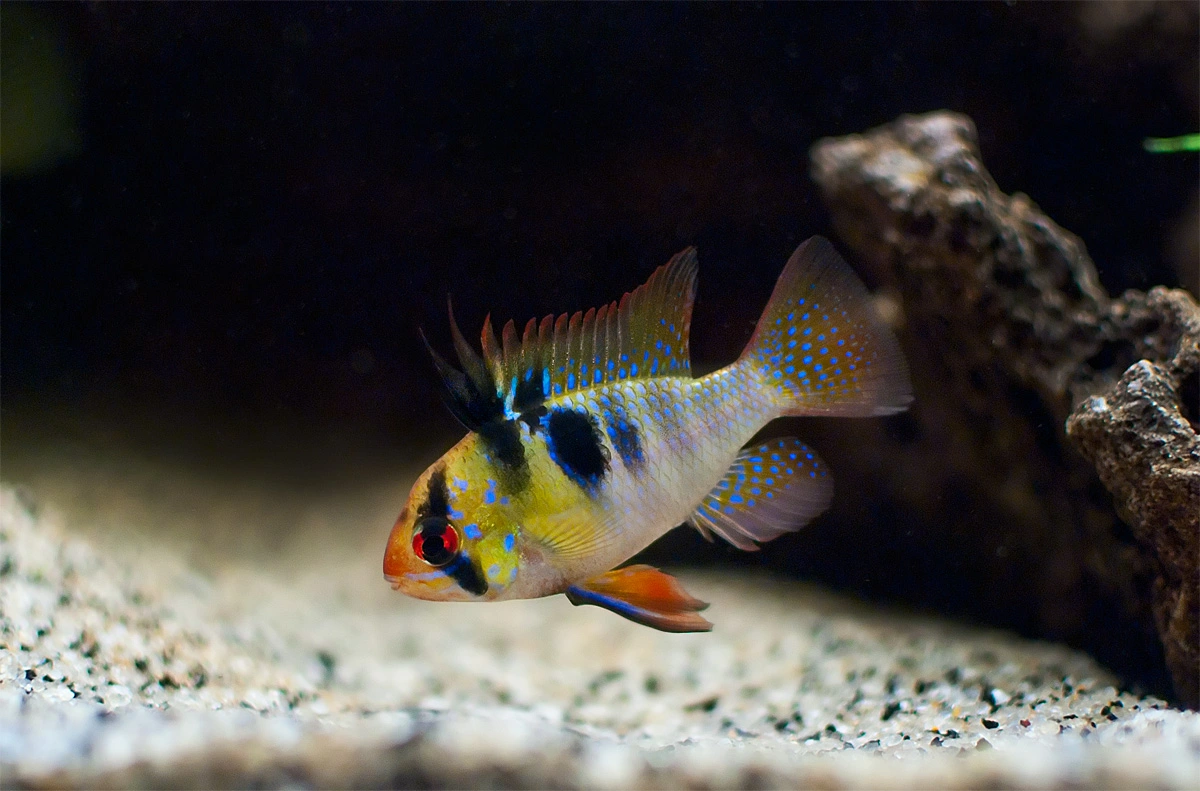
Its natural habitat is as calm as this fish’s temperament. Most of the time, this fish dwells in the shallow areas of the riverbanks. These areas are cleaner, and warmer and provide the fish with a sufficient food source. Moreover, many fallen trees and branches provide them with much-needed shelter and breeding sites.
German Blue Ram Size and Appearance
German Blue Ram is a small freshwater fish. They have body sizes ranging from 2 to 2.5 inches only, when fully grown. Their body is flat and streamlined which makes them excellent swimmers.
The German Blue Ram has an electric blue and yellow body color. This blue body is adorned with contrasting yellow hues and stripes. Moreover, its body has iridescent scales. These scales shimmer under light and mesmerize the viewer. The colors and hues on this fish may change according to their mood and usually get darker as they age. Additionally, The German Blue Ram has beautiful patterns on its fins. The colors of these patterns range from blue to hints of red and purple.
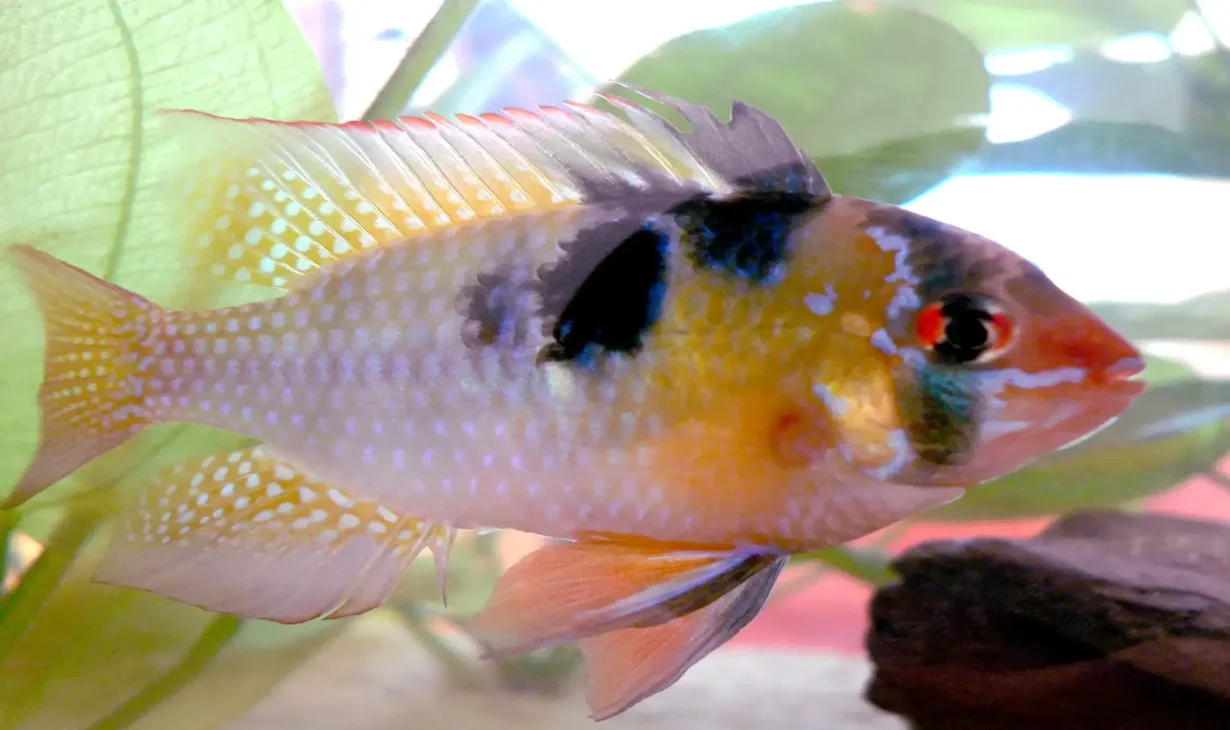
Coming to the fins, the dorsal fin is very long and has distinct black spots at the base, especially in the males. The anal fin is on the bottom of the body and looks mostly like the dorsal fin. Lastly, the pelvic and pectoral fins are translucent. Although they may have different hues. for example, in males, the fins might exhibit red or orange accents during fights or breeding. summing it up, this fish has a lot of fins that are not just beautiful but also help in maneuverability.
Moreover, this fish has red or orange eyes. These eyes look like emeralds and add to their captivating look. All this beauty combined with its agile swimming style makes this fish bedazzle any tank.
German Blue Ram behavior
Small in size, big on territory: Meet the German Blue Rams! Because of its small size, you must assume this is a peaceful fish, but that’s not the case. This fish has a very territorial nature and gets aggressive towards intruders. While mating, this aggressive nature is intensified even more.
However, this fish is generally peaceful if its territory is not disturbed. So, it’s best to give it ample space so no one’s fighting.
German Blue Rams are very active creatures in the day. They like to dwell in the middle or bottom of the tank but not at the top. In the night, this fish likes to rest and take some shelter.
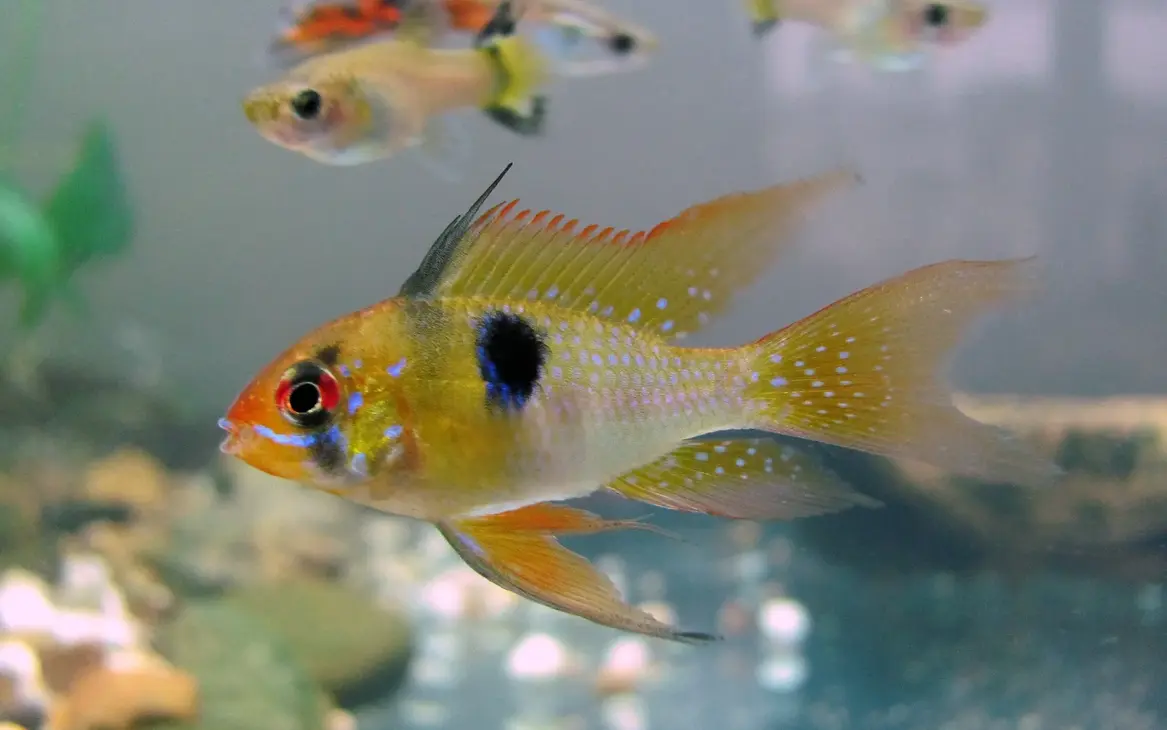
In the wild, this fish forms small pairs, although in captivity they can thrive alone and in groups. But make sure you choose the right tankmates and don’t overcrowd the tank.
In addition, the German Blue Rams have excellent parenting skills. After breeding the parents form a pair and guard the eggs. In this period, they do not attend to other mates. The parents get committed and take turns guarding the eggs. Observing this behavior is a mesmerizing view for every aquarist.
German Blue Ram Tank Size
Having the ideal tank size is very important for your tank fishies to thrive. You must have at least a 20-gallon tank for your German Blue Rams. This will provide ample space for your active fish to move freely. However, it’s better to have a bigger tank if you are keeping more than one fish in the aquarium. We recommend going for a 30-gallon tank for a pair of blue rams, as it will allow them to have their territories.
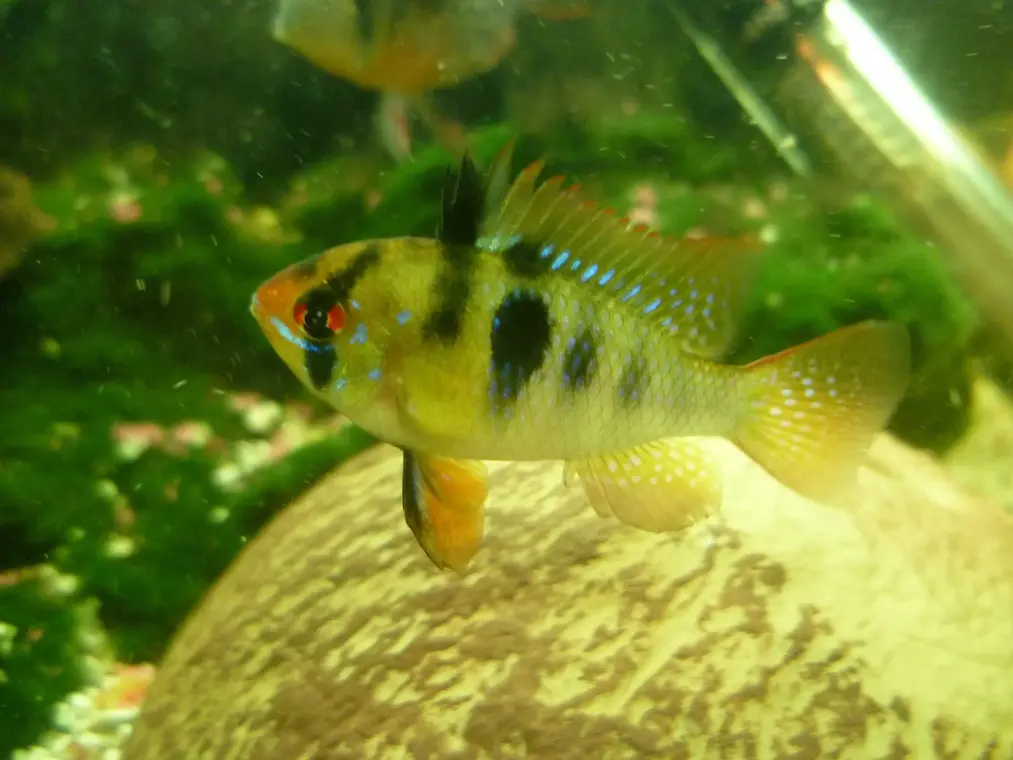
Make sure that there is always enough space for all the tankmates, as the German Blue Rams are territorial. If you overcrowd the aquarium, you can stress out the rams and cause aggression. A large tank also allows easy maintenance and better water quality so always go for some extra gallons. Additionally, it provides more space for tank decorations and shelter.
Tank Parameters and Setup
German Blue Rams are a bit picky when it comes to their environmental conditions. This fish will only thrive in specific water conditions. To maintain its health and beautiful coloration, you must provide the ideal aquarium.

The ideal German Blue Ram water temperature is 78-86°F. While the water pH must be 6.0 to 7.0 without any fluctuations. The water must be soft to moderately hard only as this fish is sensitive to water conditions. Ensure all the parameters are stable as any ups and downs can cause stress to the blue fishy. Other water parameters like nitrite and ammonia levels must be at safe levels.
German Blue Ram Tankmates
German Blue Rams have a peaceful nature. you should always consider their gentle yet territorial behavior. It’s best to have tank mates that are non-aggressive and thrive in different levels of the aquarium.
Small tetras, Corydoras catfish, or bottom-dwelling fishes are excellent choices. Their small size and peaceful nature make them compatible with the German Blue Rams. we suggest having some bottom-dwelling fish in the tank as they keep the environment clean. Some of the best Blue Ram cichlid tank mates are as under.

- Neon Tetras
- Corydoras Catfish
- Dwarf Gouramis
- Harlequin Rasboras
- Otocinclus Catfish
- Honey Gouramis
- Cardinal Tetras
- Kuhli Loaches
- Cherry Shrimp
- Ember Tetras
Always make sure that the German Blue Rams tankmates are not aggressive. Calm fishes that have a habit of nipping fins are also a big NO! Moreover, you should avoid having larger and more territorial fish as tankmates. Take note that all the tankmates must be comfortable with the tank parameters.
Tank Decoration and Substrate
The tank decoration and substrate are vital for the German Blue Rams. You should decorate the tank in a way that mimics the natural habitat of the fish. Make a lot of hiding spots with rocks, driftwood, and plants. Always make sure all of them and smooth and can’t injure the ram. You could use artificial plants but it’s best to use natural ones, they clean the tank better!
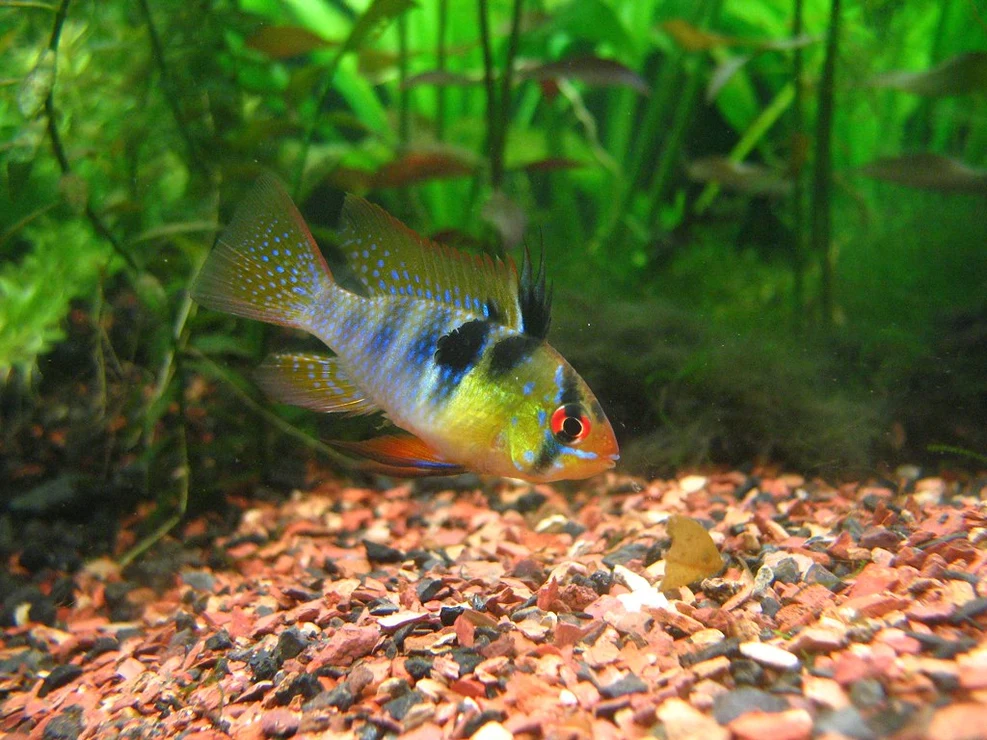
The substrate is as important as the decorations. You should use gravel, sand, or soil. A mixture of these could be good too. The gravel will increase the water flow, preventing buildup of substances. The sand will make a gentle and aesthetic look to the aquarium. Lastly, the nutrient-rich soil will promote a sustainable ecosystem in the tank.
All these combined will make a perfect tank environment for your beloved German Blue Ram. However, consider monitoring the fish’s behavior, if anything disturbs it then remove it.
German Blue Ram Diet
The German Blue Rams have a diverse diet with a lot of options. Their diet must have a mix of frozen foods, live foods, and pellet or flake foods. The combination of flakes and frozen/live foods will provide protein and nutrients.
Always maintain a varied diet, like the one they would have in the wild. Make sure you fulfill all nutrition its requirements. To maintain its health and quality of water, feed small portions many times a day. Be consistent and make sure the portions aren’t too big or small. Here are some healthy foods for German Blue Ram.
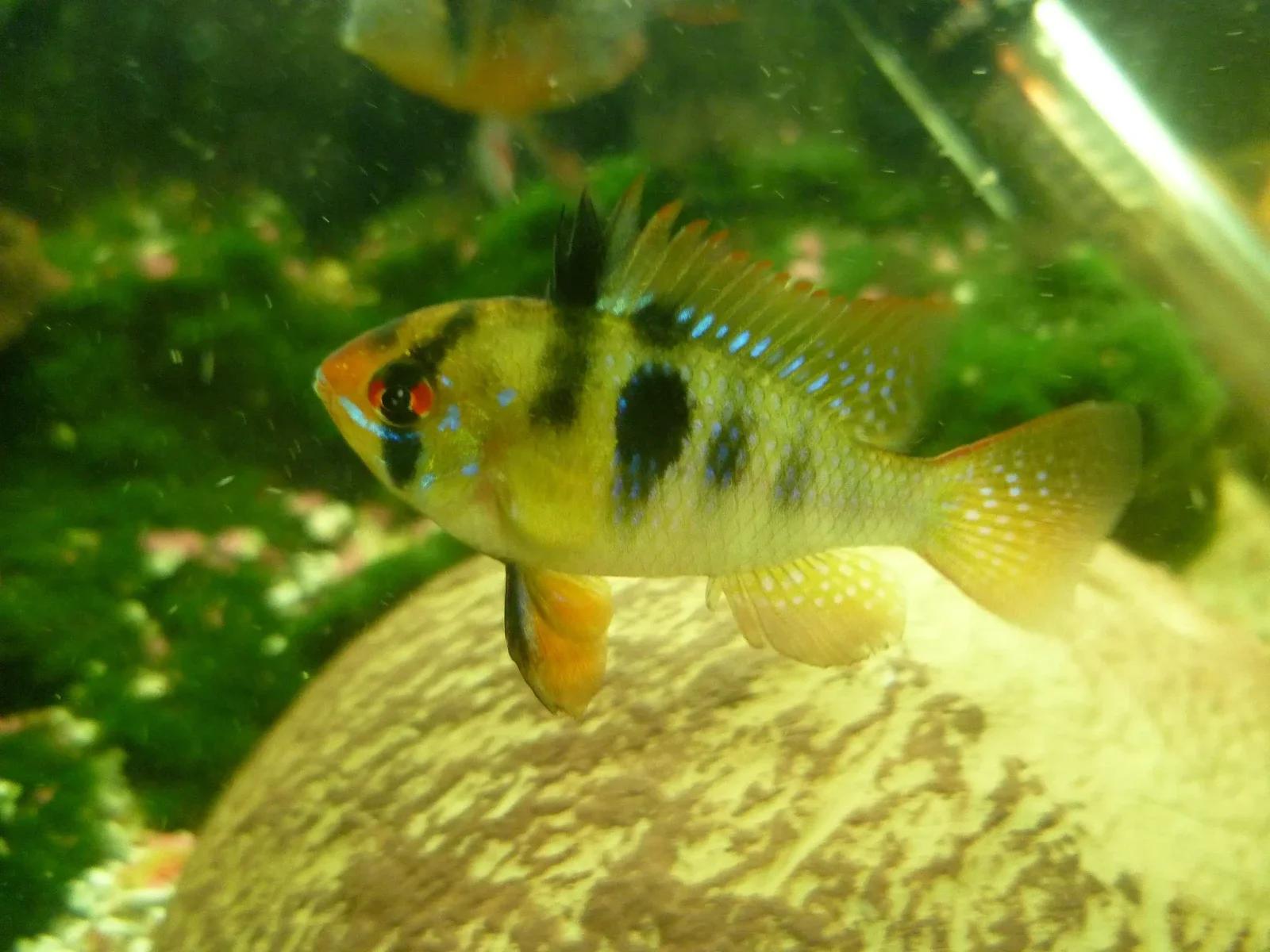
- High-quality flake food
- Small pellets made for tropical fish
- Live or frozen bloodworms
- Live or frozen brine shrimp
- Daphnia
- Tubifex worms (sparingly, due to the risk of parasites)
- Spirulina flakes or pellets
- Frozen and dried foods like daphnia or brine shrimp as occasional treats
The stomach always has a mind of its own so it’s best to monitor your pet’s eating habits. You should adjust the diet and routine according to the ram’s feeding habits. After all, you are what you eat! and the same goes for your fishy.
Breeding
The most important things while breeding a German Blue Ram are water conditions and diet. You should maintain soft water conditions with a pH of about 6.0 to 7.0. Maintaining these water parameters will encourage the breeding process.
Take the breeding pair out of the aquarium and put them in a separate tank. Provide a lot of flat surfaces and smooth substrates along with hiding spots. Use soft rocks and driftwood as this fish likes to spawn on them. It’s like a bed from their natural habitat.

To promote breeding, give the parents a protein-rich diet and keep the lights dim. As the breeding process starts, the female will lay its eggs on a soft flat spot and the male will fertilize them. Until the eggs hatch, the parents will guard them. Do not take the parents out of the tank as they aren’t harmful to the eggs. Quite the opposite, they have an excellent parenting nature. Once the eggs hatch, feed them small nutritious food and maintain water parameters.
FAQ’s
Where do blue rams come from?
The German Blue Ram is native to the Orinoco River basins in Venezuela and Colombia.
How long do German Blue Ram fish live?
Due to poor breeding practices, this fish is known to live a short life. However, if proper care is provided, this fish can live up to 4 years
How big does a German Blue Ram fish get?
This is a pretty small fish. A regular German Blue Ram can get as big as 2 to 2.5 inches.
How many blue rams should be kept together?
In a 10-gallon tank, you should only have a single Blue ram. You can have 2 of them in a 40-gallon tank
Can Blue Rams live alone?
Yes! but only if it likes to live alone. If you have an aggressive individual by any chance then it’s best to keep him alone
Are rams peaceful fish?
Yes! Rams are very peaceful in nature but they might show territorial behavior in some cases. for example, while breeding Blue rams can get quite aggressive towards other fish that trespass their territory.
Conclusion
In conclusion, that was all about The German Blue Ram Care Guide. To provide optimal care to Blue Rams, just give some attention to the water and tank setup. Offer a healthy diet, having a lot of protein and nutrients. Moreover, set up a tank that mimics the Blue Ram’s natural habitat. Maintaining such a routine will guarantee a happy and healthy life for the German Blue Ram.
We also discussed the breeding, water parameters, and tankmates for the Blue Rams. But if you still have questions or want to say something, leave a comment below!
In the end, as you start this journey with your pet, make sure you learn from it. Each pet is one of a kind and has a mind of its own. Figure out what it likes and what it doesn’t. By providing a nurturing environment, you can add this marvel to your aquarium.

